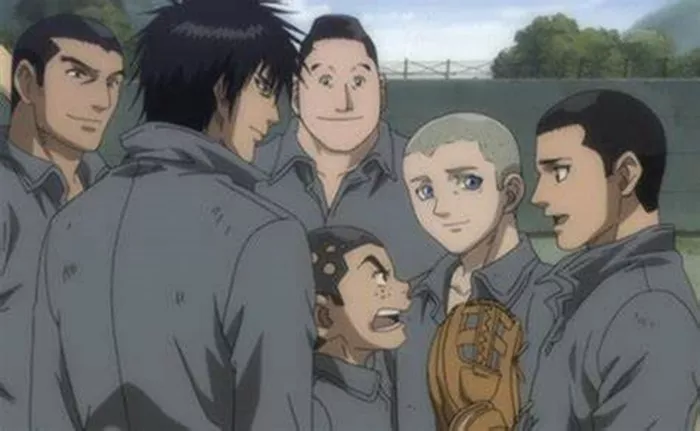In the pantheon of underrated anime, Rainbow: Nisha Rokubou no Shichinin stands as a unique, emotionally raw, and heart-wrenching masterpiece that exemplifies why anime is often heralded as a form of true artistic expression. Set in post-World War II Japan, the series offers an intense, sobering look at the lives of seven boys imprisoned in the Shōnan Special Reformatory. Through their journey, viewers witness not just survival, but the soul-crushing and often beautiful nature of human resilience. The show demonstrates, in a brutally honest way, that the boundary between art and life is often indistinguishable.
A Masterful Adaptation by Madhouse
Created during Madhouse Studio’s golden age, Rainbow is an exemplary adaptation of Masasumi Kakizaki’s manga, bringing its dark, desaturated tones and emotionally heavy narrative to life. Madhouse, known for classic anime like Death Note, Nana, and Monster, has mastered the art of balancing faithful adaptation with emotional depth. Every frame in Rainbow seems to breathe life into the gritty, post-war atmosphere of Japan, while the soundtrack and voice acting pull the audience deeper into the boys’ world of struggle and fleeting hope.
The beauty of Rainbow lies in its simplicity. It doesn’t attempt to overwhelm with grand messages or experimental art forms. Instead, it relies on the raw power of its narrative. The show tells the story of these boys—each dealing with personal trauma, loss, and societal oppression—as they bond and fight for survival. This understated narrative becomes the series’ strength, where each painful moment seamlessly transitions into a hopeful one, making Rainbow a roller-coaster of human emotions.
The Brutality of Punishment
Rainbow does not shy away from showing the cruelty of institutional punishment. The reformatory’s warden, Ishihara, embodies the sadistic discipline that serves as the series’ antagonist. His physical abuse and psychological manipulation of the boys underscore the oppressive environment. Unlike other anime where characters often endure beatings without consequence, Rainbow ensures that every punch, every act of cruelty, leaves a mark—on both the characters and the viewers.
The reformatory’s purpose is not just to discipline, but to “correct” the boys’ perceived delinquencies, a reflection of society’s harsh standards for conformity. Through relentless physical punishment and psychological control, the system attempts to strip them of their individuality. The boys are not just fighting Ishihara—they are resisting the societal structures that label them as irredeemable delinquents.
A Story About Power and Resistance
Though Rainbow is grounded in themes of cruelty and punishment, it also demonstrates a more nuanced understanding of power. The characters, led by Rokurouta Sakuragi, don’t conform to the simple binary of “good” or “bad.” Instead, they are people caught in tragic circumstances, learning to navigate life with the weight of societal expectations, economic hardship, and personal trauma.
Sakuragi’s leadership teaches the boys how to resist—not through rebellion, but through quiet defiance and the pursuit of their own aspirations. His mentorship is not about shaping them into perfect citizens, but about showing them how to find strength in themselves, even when the world seeks to break them.
In this sense, Rainbow explores the concept of power in two forms: the oppressive power of institutions and the transformative power of human relationships. It draws an unexpected parallel with series like Kaguya-Sama! Love Is War, which explores how power can be creative rather than destructive. The boys in Rainbow harness their experiences not to conform but to build their own futures, becoming stronger through their shared pain and resilience.
Finding Art in the Act of Living
At its core, Rainbow is more than a story of survival. It’s a story about the art of living—of turning one’s life into a work of art in the face of unbearable hardship. The postwar backdrop of Japan, with its economic struggles and crumbling societal norms, serves as the stage for these seven prisoners to redefine their lives. What might seem like anime clichés—friendship, willpower, and perseverance—are depicted here not as mere narrative devices, but as essential truths about human existence.
The boys’ lives are their canvas. They create something beautiful out of tragedy, each in their own way. Whether it’s through music, boxing, or personal resolve, they resist the forces that seek to destroy them by forging a path that reflects their will to live on their own terms. In the harsh reality of post-war Japan, their camaraderie becomes their lifeline, proving that even in the darkest moments, beauty and hope can be found.
Conclusion
Rainbow: Nisha Rokubou no Shichinin is a series that leaves an indelible mark. Its profound explorationof life, suffering, and resilience continues to resonate long after the final episode. The visceral, heartbreaking scenes may make viewers hesitate to rewatch it, but the sheer artistry of the narrative draws them back in. This is a show that elevates anime from mere entertainment to a medium of profound emotional and artistic expression.
For those who believe that anime is not art, Rainbow is a testament to the contrary. It demonstrates, through the trials and triumphs of seven boys, that anime can capture the rawness of human experience in ways few other art forms can.

